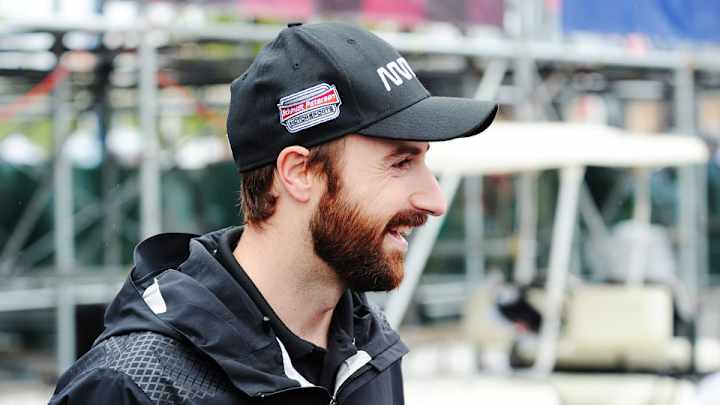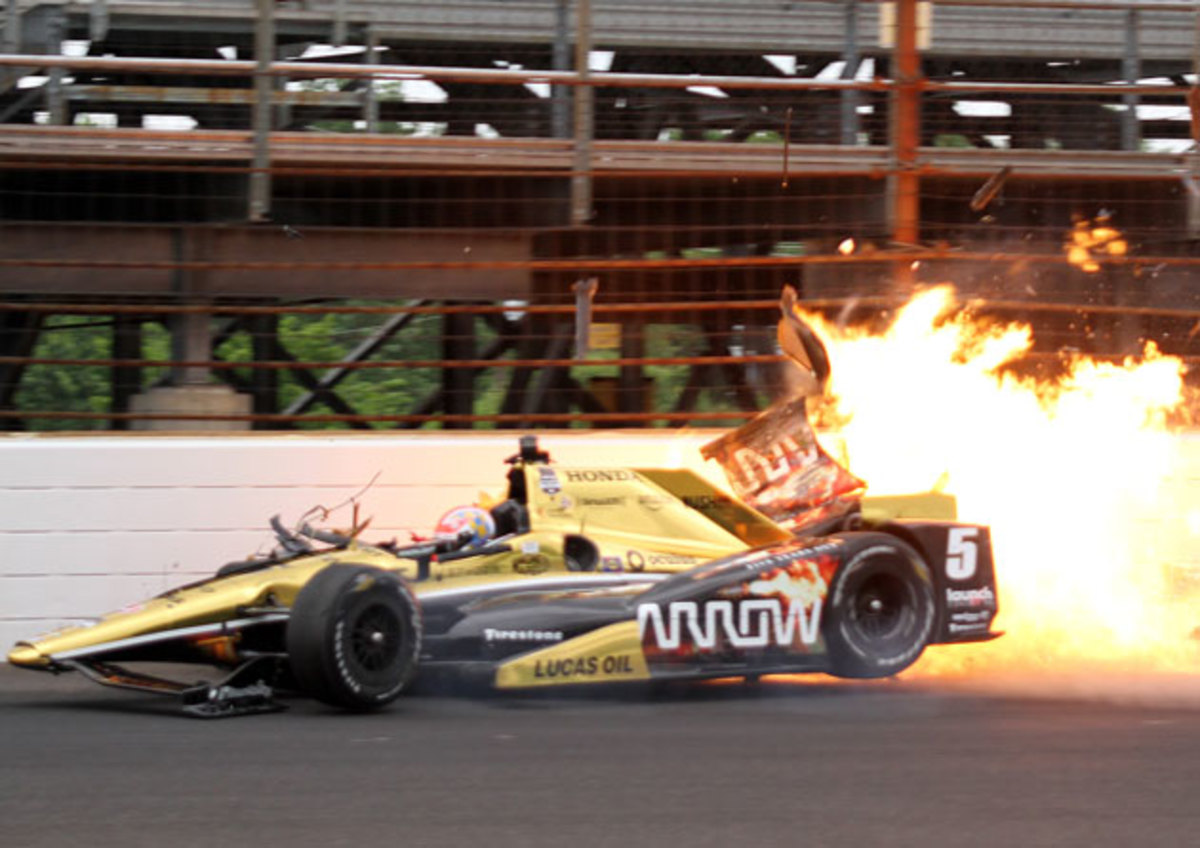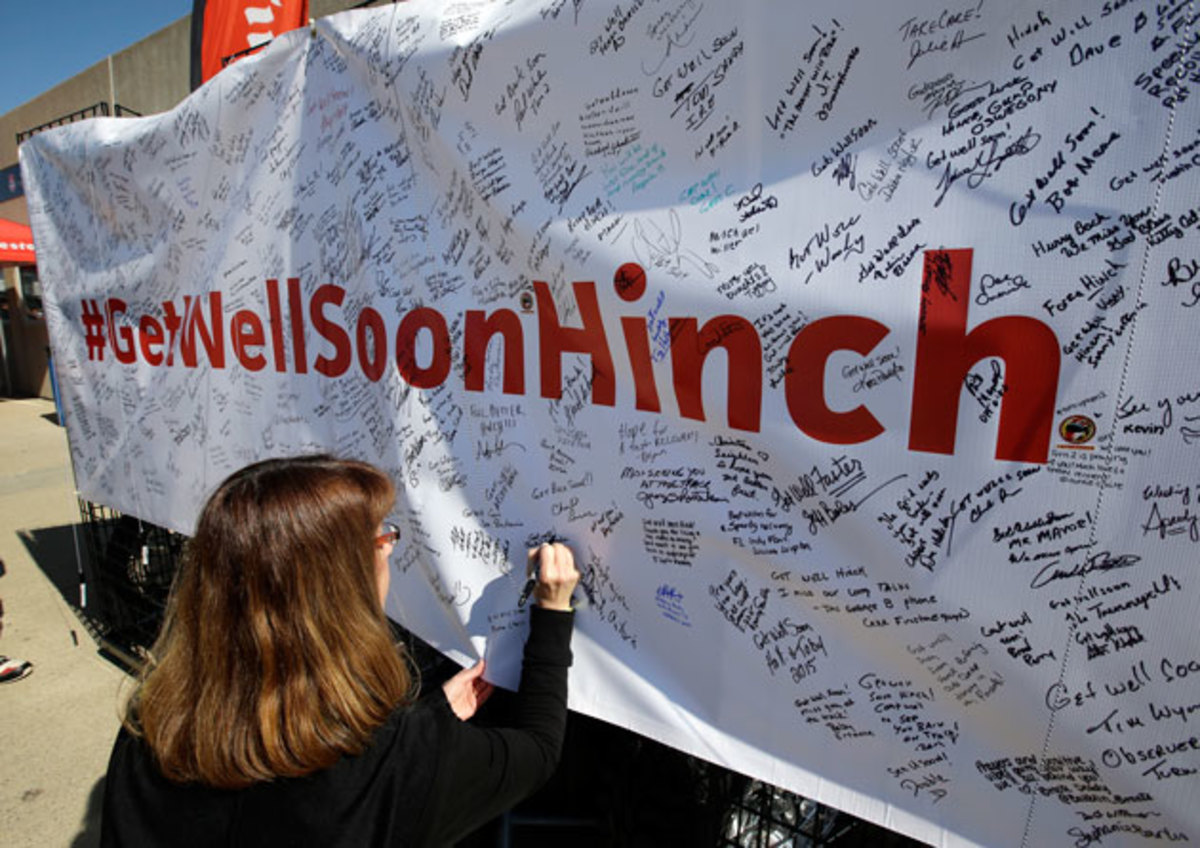James Hinchcliffe's fight to get back on the IndyCar track after grisly crash

James Hinchcliffe is at a racetrack in Elkhart Lake, Wisconsin. “The best place on earth,” the five-year IndyCar driver calls it. “My favorite road course in the country.” It’s Sunday afternoon. IndyCar is on hiatus since the end of August and won’t start up again until mid-March. It won’t stop at this place in Elkhart Lake, aka “Road America,” until late June.
This is a test, of an assortment of things related to the high functioning of his racecar: its drivetrain performance, its aerodynamic setup, its handling through a four-mile course that features 14 turns. On this day, Hinchcliffe is so concerned with the handling of his car—a Honda-powered machine he pilots for the Indianapolis-based Schmidt Peterson Motorsports, his home shop since last October—that he walks the course with his engineers to discuss its various corners and how he wants his No. 5 machine to respond to them.
• MORE:Castroneves: What Justin Wilson would have wanted
It’ll be another day before Hinchcliffe puts his car through these paces. The time can’t come quickly enough, even though Sunday is a nice day. The weather is warm but overcast—“really good testing weather,” Hinchcliffe says. “The cloud cover will make the track temperature a little bit cooler, and that’s always good for tires.” Spirits are high among his crew. “We all had bigger smiles on our faces than if I was just seeing them at the shop,” Hinchcliffe says, “because everybody knows that this is a big deal.”
Hinchcliffe’s own mood jumps like a needle counting engine revs, ticking back and forth from nervous to excited. While that might seem a bit irregular for a four-time IndyCar race winner who began racing open-wheel cars as a teenager around his native Canada, it feels about right for a 28-year-old who nearly died on a racetrack 132 days before this trip to Packer country.
***
“We just thought we’d pull him up out of there, but he wouldn’t budge. We got the spreaders out—the jaws of life—and we spread the tub out a little bit and heard a couple of cracks and pops.”
Hinchcliffe’s close call came on May 18 at Indianapolis Motor Speedway during a practice run for the Indy 500. He was rushing his Honda into the track’s third turn when it continued on a beeline and smashed into the wall. The accident was one in a series of alarming incidents at the track in less than a week’s time. But Hinchcliffe’s stood out for its ghastliness.
The impact of his crash was so violent that it shaved off most of the right side of his car, which then burst into flames. A piece of the car’s right front suspension, the part ultimately at fault for this accident, penetrated the carbon fiber tub designed to protect the driver. The stray suspension link went on to break Hinchcliffe’s pelvis, impale his right buttock and left thigh and sever his left femoral artery.

Meanwhile, team owner Sam Schmidt was busying himself with admin work inside his motor coach. “And then I saw the car sitting there,” he recalls, “and then I saw the replay, and I’m like, ‘Holy crap…’”
For 20 perilous seconds Hinchcliffe sat pinned to his seat, his firesuit bottom filling with warm blood. Ultimately, Hinchcliffe was rescued by IndyCar’s Holmatro safety team, a traveling emergency response unit comprised of trauma doctors and nurses who know IndyCar drivers down to their blood types and EMTs who know the way around racecar crashes.
Still, says Mike Yates, IndyCar’s manager of track safety ops and one of the first Holmatro crew members to arrive on scene, “the thing we couldn’t figure out is why we couldn’t move him in his seat. We just thought we’d pull him up out of there, but he wouldn’t budge. We got the spreaders out—the jaws of life—and we spread the tub out a little bit and heard a couple of cracks and pops.”
Once Yates noticed Hinchcliffe’s heavy bleeding, the race was on to get him into an ambulance. The clock was ticking. “We didn’t know that the suspension was through his hip,” Yates continues. “We decided we had to go or he was going to bleed to death. I told him, ‘This is gonna hurt, but when we start working we’re not gonna stop until we get you out of the car. We kept pulling, and finally he came clear of the car and onto the backboard.’”
As the Holmatro crew freed Hinchcliffe, Yates heard a clanging sound reverberate in the cockpit. “I thought somebody had dropped a radio,” he says. “But what that was was the suspension part that we were pulling him off of actually slipping back down into the seat.”
Within minutes they rushed Hinchcliffe down 16th Street to Indiana University Health Methodist Hospital. If it hadn’t been for the Holmatro team’s quick work, Hinchcliffe probably wouldn’t have lived to tell this tale, let alone the one that comes next: the comeback. As for the grisly bit that came before, Hinchcliffe still has no memory of it. “Yeah,” he says, “luckily.”
***
It really does just show that anything can happen in this sport because one of those accidents wasn’t necessarily worse than the next. The outcomes can be so massively different.
Hinchcliffe’s comeback story is still developing. The first bit of good news came less than 24 hours later, after he came to from an emergency operation. Timothy Pohlman, the IU Health surgeon who tended to Hinchcliffe, pronounced the driver “stable and improving.” IndyCar officials ruled him out indefinitely. Hinchcliffe, it appeared, would be road-worthy again. All he had to do upon discharge from the hospital (which came a week following the accident, after another surgery) was chill.
For a driver who prefers to keep a brisk pace off the track while connecting with people, who fancies himself as the mayor of an online fan community called “Hinchtown,” this was frustrating as hell. “I was pretty much couch-ridden for two months after the accident to let my body recover as much as it could,” says Hinchcliffe, whose thumbs at least were strong enough to keep him “in office” on social media, where the shows of support overwhelmed him. “And then I slowly started getting clearances to do some physical activity.”
After kicking painkillers early and scoring a few early victories in rehab—regaining his balance; rebuilding the stamina to walk, one step at a time; re-firing his upper body muscles—Hinchcliffe set his mind to returning to the track. He started slowly in early June, making a surprise remote appearance on the massive video board at Texas Speedway to give the command for that day’s IndyCar race. The following weekend he turned up in the flesh at IndyCar’s next stop, in Toronto, to do pretty much the same thing again.
SI Now remembers Justin Wilson
“The Toronto trip definitely took a toll on me,” he says. “Normally that week for me is completely packed with appearances and events, but I had to cancel all of them. I was moving very slowly. My energy levels still weren’t super high. My goal was to be back at the racetrack with my team watching the sessions, learning, contributing in any way that I could.”
Sometimes, standing on the sideline while two other drivers took turns racing his car—first a versatile open-wheel veteran from Australia named Ryan Briscoe, then a talented young American named Conor Daly—was “like watching someone else take your girlfriend out on a date,” Hinchcliffe says. Other times, it was a relief. "In all honesty, when I first started coming back to the track, I still felt so bad that the thought of driving a racecar was massively unappealing to me.” It wasn’t until a third and final surgery, in late-July, that Hinchcliffe became obsessed with getting back together with his old girl.
By then he had been medically cleared to pick up his old training regimen. This proved easier said than done after an idle period that left the 5'9'', 161-pound Hinchcliffe some 12 pounds lighter. “It’s incredibly physically demanding to drive an IndyCar at speed,” he says. “I knew that sitting on a couch for two, two-and-a-half months, you lose a lot of your fitness. You have a ton of muscle atrophy.
“As soon as I was cleared to start doing any sort of physical movement and exercise, I was doing it. And every time I got a new clearance, I would start doing that, start pushing, start building back up everything that I had lost. There were times where that was very tough and very frustrating because the last time I had done this or that particular exercise, I was 300 percent better at it. As a competitor, as an athlete, that’s a tough thing to accept. But it does also motivate you to just push harder to get back to where you know you can be.”
Hinchcliffe is also just as aware of where he could’ve been if the Holmatro crew hadn’t acted so swiftly or, worse, if that stray piece of suspension had hit a millimeter or so off its target. This really hit home on Aug. 24, when fellow IndyCar driver Justin Wilson died from injuries he suffered after being struck in the head by a large piece of crash debris during the season’s penultimate race at Pocono.
Wilson’s passing, at age 37, has led to much decrying about safety. Some have suggested canopies for IndyCars’ open-air cockpits. Others wonder if the series should stop racing on ovals, where high speeds create the equally high potential for such tragic events. One has called for IndyCar to close up shop altogether.
Hinchcliffe, however, would prefer if folks took a page out of his book and chilled for a second. He thinks a little perspective could be helpful. Consider Wilson’s accident along with his own and the scary tumble that Briscoe took in Hinchcliffe’s car on June 27 at Fontana, he says, and folks will see racing accidents for what they are: equal parts inevitability and fluke, an inescapable reality of a sport that’s all about testing limits.
“You have three bad accidents,” he starts. “One of ’em, the guy [Briscoe] walks away completely fine. One of ’em, the guy’s injured [Hinchcliffe] but eventually will make a comeback. One of ’em we lost a driver. It really does just show that anything can happen in this sport because one of those accidents wasn’t necessarily worse than the next. The outcomes can be so massively different.

“Anytime something bad happens there’s a tendency for knee-jerk reactions. I think that as a sport, we need to be very measured and very calculated in what we do. There is no doubt in my mind that IndyCar is always pushing safety. We as a series were the developers of the SAFER barrier, the first series to implement the Hans device. The DW12 [chassis] was introduced with mandatory blocks of foam to help energy absorption in certain impacts.
“There are always things that we are doing to make things safer. The most important thing is that anything new that we do to or add to our cars we need to make sure that they solve more problems than they create. Because it’s very easy to throw something at a car to solve a specific problem and not really appreciate that it can actually make a lot of other situations a whole lot worse.”
So they keep testing.
***
“The trees down the back straight are all changing color—although I should’ve been focused probably more on the road at 180, 190 miles an hour down. But I couldn’t help but take in the scenery a little bit.”
Monday finally dawns at Road America. Hinchcliffe pulls up to the track around 7 a.m. Slowly, his teammates filter in. He greets each the same way, with a cheery “Merry Christmas!” The conditions on track are slightly different than the day before. The cloud cover is mostly gone, and the great swaths of sunlit sky tip temperatures into mid-80s.
That’s not all that goes against the forecast. There’s no give in Hinchcliffe’s firesuit. Likewise his race seat, which is made bespoke to his frame, fits snuggly. For a driver who was a husk of himself not that long ago, this was a sign of good things to come.
After jumping rope for a while in the pits to warm up his muscles and get the blood pumping, Hinchcliffe straps in. Over the radio Nick Snyder, the No. 5 car’s engineering manager, gives Hinchcliffe the command. He fires the engine and guns it out of the pits.
His Honda machine is fast on the straights and stable through the bends. Hinchcliffe’s body feels good, especially his neck, which was also severely hurt in the Indy crash. “That’s just one of the hardest things to train in a gym,” he says, “the way that it reacts to the forces in the car.”
Fully at ease for the first time in four months, Hinchcliffe loses himself in the moment. “It was honestly a great, a beautiful day in Wisconsin in the fall,” he says. “The trees down the back straight are all changing color—although I should’ve been focused probably more on the road at 180, 190 miles an hour down. But I couldn’t help but take in the scenery a little bit.” At one point during his run, Snyder radios Hinchcliffe. “Finish the lap and pit,” he says.
“No,” Hinchcliffe radios back. “I’m not coming in. Ever.”
Of course, Hinchcliffe does come in eventually, and then again and again, and then for good. By then it’s shortly before 5. “We had a really, really good day,” he says, still buzzing. “It was not only productive from a team setup point of view but I felt great in the car. I felt like I got up to speed very quickly.”
His boss exhales. “You go for the first two weeks and everybody’s positive,” says Schmidt, who overcame his own on-track calamity. “You say it and you hope and you encourage and you motivate, but you never really know until it happens. And so it happened. But this isn’t the goal line. It’s the start of a whole ’nother process.”
Now the really hard work begins for Hinchcliffe. Next year, there will be races to win and a series championship to hunt down. There will be a host of rival drivers trying to deny him at every turn. But after acing Monday’s test, Hinchcliffe knows he’s up for the challenge. He comes away from the experience having learned a lot about his car, yes, but even more about himself. “It was just nice to know that all the hard work that had gone into the last four months has really paid off,” he says. “I’m definitely further than I thought I would be or where I expected to be, which is awesome.”
